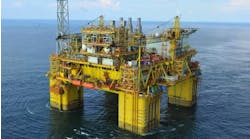David Paganie
Senior Editor
Chevron’s Angolan subsidiary Cabinda Gulf Oil Co. Ltd. (CABGOC) and partners used an innovative development scheme to exploit reserves off the coast of Malongo, Cabinda. While the project showcases many industry firsts, it also serves the environment by reducing routine gas flaring in the area.
Heerema Marine Contractors’ semisubmersible Thialf (in the background) performed installation of the complex’s topsides modules and platform connection bridges.
First condensate production was achieved from the Sanha field in January at an average rate of 6,000 b/d of condensate. The associated dry gas is being re-injected into the reservoir to maintain pressure and for storage. The Sanha condensate complex is located in the Block O concession, approximately 23 mi offshore in 65 m of water.
The $1.9-billion project comprises three bridge-connected platforms, a remote emergency flare, a stand-alone oil and gas production platform, a newly built FPSO vessel, and more than 62 mi of pipeline.
At peak production, the project will produce about 90,000 b/d of oil and oil equivalent in the form of condensate - a light, liquid hydrocarbon similar to gasoline - and liquefied petroleum gas (LPG) - a mixture of even lighter butane and propane. Both condensate and LPG are produced along with natural gas.
Most of the production will come from 50 plannedwells on the Sanha and Bomboco fields (Sanha, 35 production and injection wells, and Bomboco, 15 production wells). More than $700million has been earmarked to drill the 50 wells over the course of three years.
The Sanha complex has three bridge-connected platforms - one for drilling and production; one for processing, compression and re-injection, and one for accommodation. The complex will process some oil and 300 MMcf/d of gas.
In addition, three existing platforms - East Kokongo, North N’Dola and South Sanha - will pipe their associated gas (currently flared) along with gas from Bomboco to the Sanha complex, where the wet gas will be stripped of condensate and LPG.
The condensate will be mixed with the oil and transported by pipeline to the Malongo terminal for export. The LPG will be sent to a permanently moored FPSO, where a depropanizer will process the LPG so that export tankers can load pure butane and propane. An existing platform in Area A, called F-GIP, will contribute its 4,000 b/d directly to the Sanha LPG FPSO.
After being stripped of condensate and LPG, the 500 MMcf/d of dry gas will be re-injected into the Sanha reservoir to maintain pressure and reduce routine flaring in block O by more than 50%. This reduction will eliminate 2.2 million tons of carbon dioxide emissions per year.
Heerema Marine Contractors’ semisubmersible Thialf performed installation of the complex’s topsides modules and platform connection bridges. One of the topsides modules weighed 10,290 metric tons, resulting in the largest single offshore lift ever in West Africa. Stolt Offshore was also involved in the installation activities.
On May 8, 2005, the Sanha LPG FPSO, built by IHI Marine United, Inc., received first LPG through a 6-in riser. The innovative purpose-built LPG FPSO is owned by Sonasing and operated by OPS, two joint ventures comprised of SBM and Sonangol. The 92,700-dwt vessel is moored on site in 58 m of water via an external turret system. The FPSO was designed and built to remain on site for 20 years without drydocking. Cabgoc has secured the floater through an eight-year contract with Sonasing and OPS for operations on Sanha through May 2013.•
null
null
null







